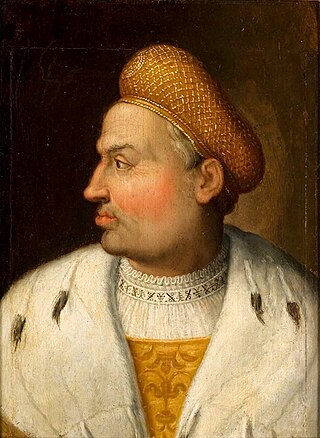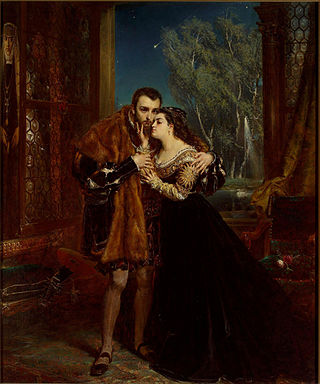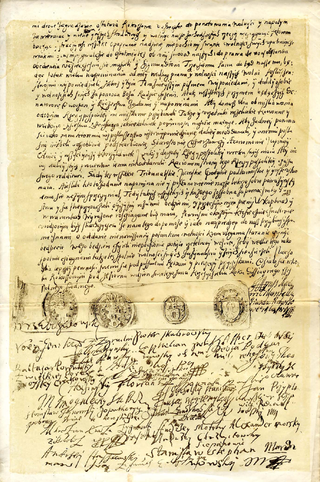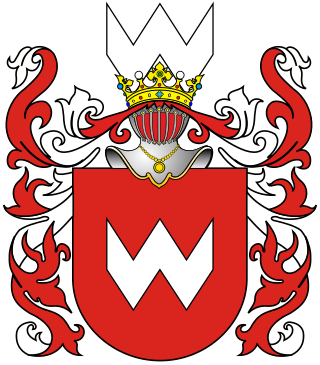
Sigismund II Augustus was King of Poland and Grand Duke of Lithuania, the son of Sigismund I the Old, whom Sigismund II succeeded in 1548. He was the first ruler of the Polish–Lithuanian Commonwealth and the last male monarch from the Jagiellonian dynasty.

Sigismund I the Old was King of Poland and Grand Duke of Lithuania from 1506 until his death in 1548. Sigismund I was a member of the Jagiellonian dynasty, the son of Casimir IV and younger brother of Kings John I Albert and Alexander I Jagiellon. He was nicknamed "the Old" in later historiography to distinguish him from his son and successor, Sigismund II Augustus. Before ascending to the Polish and Lithuanian thrones, he was Duke of Głogów from 1499, Duke of Opava from 1501, and governor of Silesia from 1504 on behalf of his brother, King Vladislaus II of Bohemia and Hungary.

Sigismund III Vasa was King of Poland and Grand Duke of Lithuania from 1587 to 1632 and, as Sigismund, King of Sweden and Grand Duke of Finland from 1592 to 1599. He was the first Polish sovereign from the House of Vasa. Religiously zealous, he imposed Catholicism across the vast realm, and his crusades against neighbouring states marked Poland's largest territorial expansion. As an enlightened despot, he presided over an era of prosperity and achievement, further distinguished by the transfer of the country's capital from Kraków to Warsaw.

The Polish Golden Age was the Renaissance period in the Kingdom of Poland and the Grand Duchy of Lithuania, roughly corresponding to the period of the Jagiellonian dynasty (1386-1572). Some historians argue that the Polish Golden Age continued into the mid-17th century, when the Polish–Lithuanian Commonwealth was ravaged by the Khmelnytsky Uprising (1648–57) and by the Swedish and Russian invasion. During its Golden Age, the Commonwealth became one of the largest kingdoms of Europe and at its peak stretched from modern-day Estonia in the north to Moldavia in the south and from Moscow in the east to Brandenburg in the west.

Bona Sforza was Queen of Poland and Grand Duchess of Lithuania as the second wife of Sigismund the Old, and Duchess of Bari and Rossano by her own right. She was a surviving member of the powerful House of Sforza, which had ruled the Duchy of Milan since 1450.
A rokosz originally was a gathering of all the Polish szlachta (nobility), not merely of deputies, for a sejm. The term was introduced to the Polish language from Hungary, where analogous gatherings took place at a field called Rákos. With time, "rokosz" came to signify an armed, semi-legal rebellion by the szlachta of the Polish–Lithuanian Commonwealth against the king, in the name of defending threatened liberties. The nobles who gathered for a rokosz formed a "confederation".

A konfederacja was an ad hoc association formed by Polish–Lithuanian szlachta (nobility), clergy, cities, or military forces in the Polish–Lithuanian Commonwealth for the attainment of stated aims. A konfederacja often took the form of an armed rebellion aimed at redressing perceived abuses or trespasses of some authority. Such "confederations" acted in lieu of state authority or to force their demands upon that authority. They could be seen as a primary expression of direct democracy and right of revolution in the Commonwealth, and as a way for the nobles to act on their grievances and against the state's central authority.
Lubomirski's rebellion or Lubomirski's rokosz, was a rebellion against Polish King John II Casimir that was initiated by Jerzy Sebastian Lubomirski, a member of the Polish nobility.

Isabella Jagiellon was the queen consort of Hungary. She was the oldest child of Sigismund I the Old, King of Poland, and his Italian wife Bona Sforza.

Zebrzydowski's rebellion, or the Sandomierz rebellion, was a rokosz in the Polish–Lithuanian Commonwealth against King Sigismund III Vasa. The rokosz, formed on 5 August 1606 by Mikołaj Zebrzydowski, Jan Szczęsny Herburt, Stanisław Stadnicki, Aleksander Józef Lisowski, and Janusz Radziwiłł in Stężyca and Lublin, was caused by the growing dissatisfaction with the King among the szlachta. In particular, the rebels disapproved of the King's efforts to limit the power of the nobles, his attempts to weaken the Sejm and to introduce a hereditary monarchy in place of the elective one. The rebellion (1606–1609) ended in the defeat of the rebels, but the szlachta, in return for their surrender, now controlled the monarchy in the Polish–Lithuanian political system.

Mikołaj Zebrzydowski (1553–1620) of Radwan coat of arms, voivode of Lublin from 1589, Crown Grand Marshal between 1596–1600, voivode of Kraków from 1601. He is famous for an armed rebellion against King Sigismund III Vasa, the Zebrzydowski Rebellion, a rokosz named after himself. It took place in 1606, and was defeated by 1607. After the failed rebellion, he sponsored the creation of the Roman Catholic monastery of Kalwaria Zebrzydowska, which is regarded as one of the most important pilgrimage sites of Poland.

Marie Louise Gonzaga was Queen of Poland and Grand Duchess of Lithuania by marriage to two kings of Poland and grand dukes of Lithuania, brothers Władysław IV and John II Casimir. Together with Bona Sforza (1494–1557), she is regarded as one of the most influential and powerful queen consorts of the Kingdom of Poland and the Polish–Lithuanian Commonwealth.

Elizabeth of Austria was Queen of Poland by marriage. She was the eldest of fifteen children of Ferdinand I, Holy Roman Emperor, and his wife Anne of Bohemia and Hungary. A member of the House of Habsburg, she was married to Sigismund II Augustus, who was already crowned as King of Poland and Grand Duke of Lithuania even though both of his parents were still alive and well. The marriage was short and unhappy. Elizabeth was of frail health, experiencing epileptic seizures, and died at age 18.

Achinger is a Polish coat of arms. It was used by several szlachta families in the times of the Kingdom of Poland and the Polish–Lithuanian Commonwealth.

The Lviv High Castle is a historic castle located on the top of the Castle Hill of the city of Lviv, Ukraine. It is currently the highest point in the city, 413 metres (1,355 ft) above sea level. The castle currently stands in ruins.
The history of the Polish–Lithuanian Commonwealth (1569–1648) covers a period in the history of Poland and Lithuania, before their joint state was subjected to devastating wars in the mid-17th century. The Union of Lublin of 1569 established the Polish–Lithuanian Commonwealth, a more closely unified federal state, replacing the previously existing personal union of the two countries. The Union was largely run by the Polish and increasingly Polonized Lithuanian and Ruthenian nobility, through the system of the central parliament and local assemblies, but from 1573 led by elected kings. The formal rule of the nobility, which was a much greater proportion of the population than in other European countries, constituted a sophisticated early democratic system, in contrast to the absolute monarchies prevalent at that time in the rest of Europe.[a]

Konstanty Korniakt was a merchant of Greek descent, active throughout Central and Eastern Europe; a leaseholder of royal tolls who collected customs duty on behalf of the king. During his lifetime he was the wealthiest man in Lviv and even owned numerous villages. He was a wholesale merchant and founder of the Korniakt family dynasty.

The Jagiellonian or Jagellonian dynasty, otherwise the Jagiellon dynasty, the House of Jagiellon, or simply the Jagiellons, was the name assumed by a cadet branch of the Lithuanian ducal dynasty of Gediminids upon reception by Jogaila, the Grand Duke of Lithuania, of baptism as Ladislaus in 1386, which paved the way to his ensuing marriage to the Queen Regnant Hedwig of Poland, resulting in his ascension to the Crown of the Kingdom of Poland as Ladislaus II Jagiełło, and the effective promotion of his branch to a royal dynasty. The Jagiellons were polyglots and per historical evidence Casimir IV Jagiellon and his son Saint Casimir possibly were the last Jagiellons who spoke in their patrilineal ancestors' Lithuanian language; however, even the last patrilineal Jagiellonian monarch Sigismund II Augustus maintained two separate and equally lavish Lithuanian-speaking and Polish-speaking royal courts in Lithuania's capital Vilnius. The Jagiellons reigned in several European countries between the 14th and 16th centuries. Members of the dynasty were Kings of Poland (1386–1572), Grand Dukes of Lithuania, Kings of Hungary, and Kings of Bohemia and imperial electors (1471–1526).
Katarzyna Telniczanka (1480–1528), was a Polish noble. She was the royal mistress of king Sigismund I the Old, and the mother of three children by the monarch.

Jan Konarski (1447–1525) was a Polish nobleman who was Bishop of Kraków (1503–1524).

















